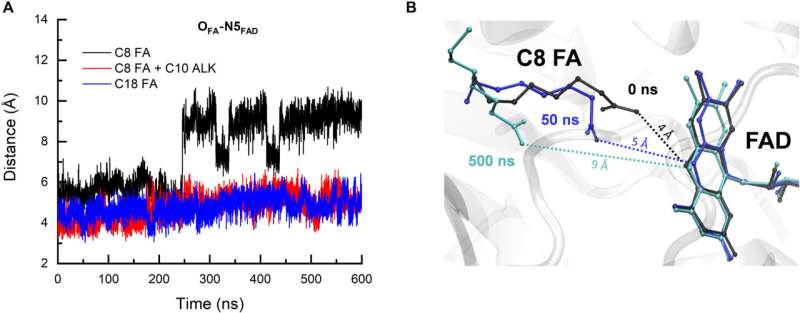April 14, 2023 report
This article has been reviewed according to Science X's editorial process and policies. Editors have highlighted the following attributes while ensuring the content's credibility:
fact-checked
peer-reviewed publication
trusted source
proofread
An autocatalytic effect that boosts the production of medium-chain hydrocarbons by FAP

A team of chemists from Aix-Marseille University, Université Paris-Saclay and Institut Polytechnique de Paris has discovered that the chlorella variabilis fatty acid photodecarboxylase (CvFAP) can be used to convert octanoic acids four times faster than hexadecanoic acids.
In their study, reported in the journal Science Advances, the group tested fatty acid photodecarboxylase (FAP) and discovered a process to convert an 8-carbon fatty acid to a liquid hydrocarbon much faster than prior processes. Also, the editors at Nature have published a Research Highlights article outlining the work done by the team on this new effort.
As climate change progresses, scientists around the world continue to look for ways to stop or reduce carbon emissions. One of the main areas of focus is the huge amounts of CO2 emitted by automobiles. Scientists would like to find a replacement for the fossil fuels with fuels that do not emit carbon dioxide. One possibility is the use of natural processes that can convert natural ingredients into cleaner fuel, such as algae conversion of fatty acids found in fats and oils into hydrocarbons.
Such processes are driven by FAP, which is powered through sunlight conversion. Unfortunately, research efforts have been unsuccessful at producing large amounts of hydrocarbons that can be used as a fuel because the process typically involves deriving fatty acids that have long chains of carbon atoms. In this new effort, the research team found an autocatalytic effect that dramatically boosts the production of short carbon-atom chained hydrocarbons.
In their work, the researchers tested the use of FAP in solutions containing 8-carbon atom chains of fatty acids. They found that when exposed to light, the enzyme chlorella variabilis was able to convert such chains to a liquid hydrocarbon up to four times as fast as those using 16-atom chains—possibly opening the door to using CvFAP as a way to mass produce and sell a much greener type of hydrocarbon fuel.
More information: Poutoum P. Samire et al, Autocatalytic effect boosts the production of medium-chain hydrocarbons by fatty acid photodecarboxylase, Science Advances (2023). DOI: 10.1126/sciadv.adg3881
Journal information: Science Advances , Nature
© 2023 Science X Network





















